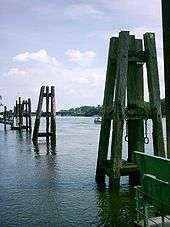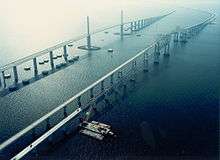Dolphin (structure)
A dolphin is a man-made marine structure that extends above the water level and is not connected to shore.


Usage as mooring point
Dolphins are usually installed to provide a fixed structure when it would be impractical to extend the shore to provide a dry-access facility, for example, when the number of ships is greater than can be accommodated by the length of the berth/pier.[1] Typical uses include extending a berth (a berthing dolphin) or providing a mooring point (a mooring dolphin).
Usage to protect structures
Dolphins are also used to protect structures from possible impact by ships, in a similar fashion to boating fenders.[2] A notable example of dolphins used to protect a bridge is the Sunshine Skyway Bridge across the mouth of Tampa Bay. In 1980, a freighter hit a pier on one of the bridge's two, two-lane spans causing a 1,200-foot (370 m) section of the bridge to fall into the water, resulting in 35 deaths. When a replacement span was designed, a top priority was to prevent ships from colliding with the new bridge.[3] The new bridge is protected by 36 dolphins: four large dolphins protecting the two main pylons supporting the cable-stayed main span plus 32 smaller dolphins protecting bridge piers for 1/4 mi (1/2 km) to either side of the main span.[3] The cost of the dolphins was $41 million (approximately $90 million in 2017 dollars).[3]
Other usage
Dolphins are also used to house navigation aids such as lights or daybeacons, and display regulatory information such as speed limits and other safety information, or advertising.
Structure
Dolphins typically consist of a number of piles driven into the seabed or riverbed, and connected above the water level to provide a platform or fixing point. The piles can be untreated wood, pressure treated pine wood poles, or steel or reinforced concrete beams, blocks or tubes. Smaller dolphins can have the piles drawn together with wire rope, but larger dolphins are typically fixed using a reinforced concrete capping or a structural steel frame.
Access to a dolphin may be via a pedestrian bridge in the case of mooring dolphins, but is usually by boat.
References
- Tsinker, Gregory P. Port engineering: planning, construction, maintenance, and security. John Wiley & Sons. p. 474.
- "Robert Cabral, Plaintiff-appellant, v. Healy Tibbits Builders, Inc., Defendant-appellee United States Court of Appeals, Ninth Circuit. - 128 F.3d 1289". 15 October 1997. Retrieved 30 November 2010.
- Scherberger, Tom (March 22, 1987). "The Lesson - A Bridge On Guard Span's Protective Shield Called Best In The World". The Orlando Sentinel. Retrieved 29 April 2018.